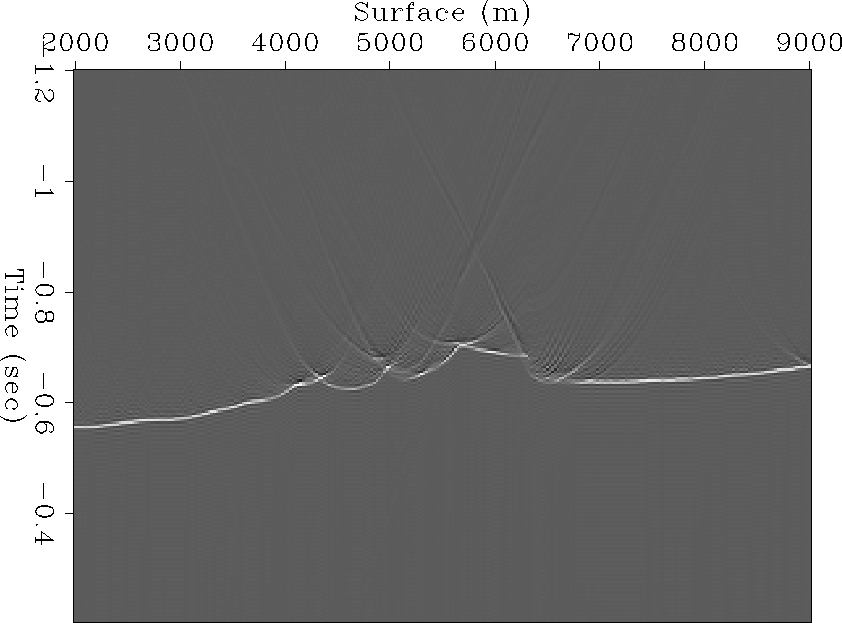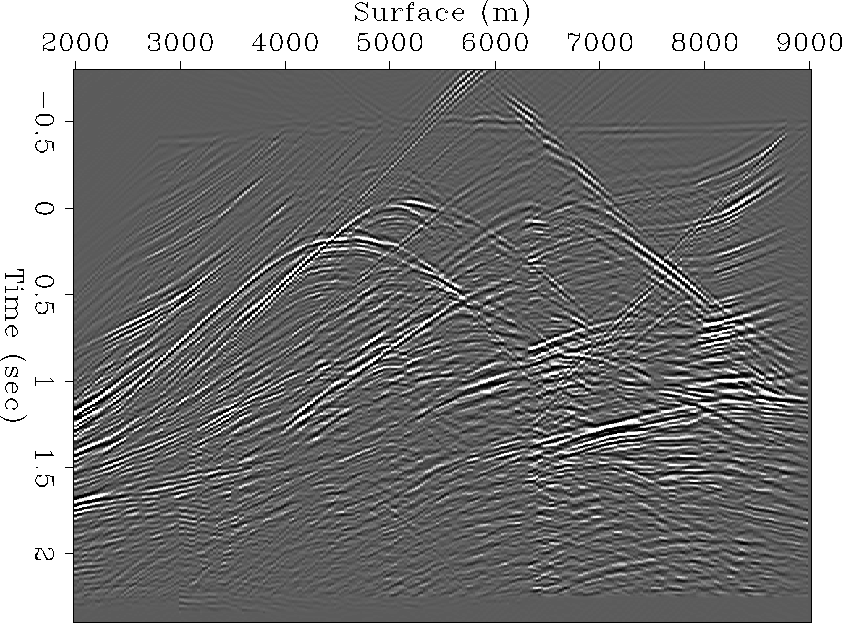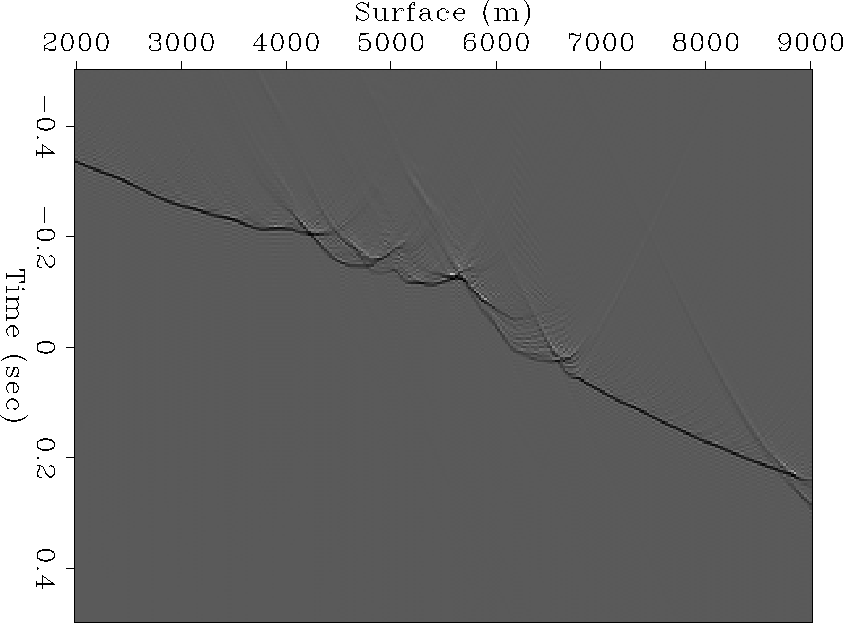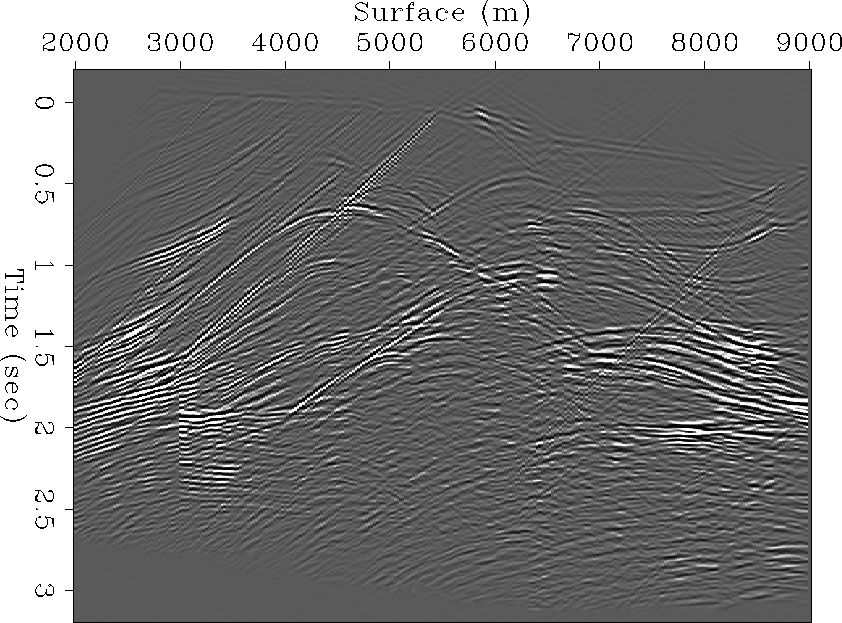If the reflector we are interested in is not flat or if the velocity of the overburden medium has strong lateral variation, the surface-oriented wavefront synthesis does not produce a stack that has equally strong amplitude along the reflection from the reflector. The irregular amplitude of the reflected wavefield can be explained by the wavefront distortion resulting from the strong lateral velocity change or the variation of the incidence angle of the wavefront to the reflector from place to place.
Therefore, clear illumination of reflectors that are nonflat or located under a complex velocity overburden require target-oriented wavefront synthesis Claerbout (1976); Rietveld et al. (1992); Schultz and Claerbout (1978). In other words, we need a synthesis operator whose wavefront is a plane at a certain depth or along an irregular reflector, not at the surface. Using the property of the wavefield extrapolation operator that is close to unitary, we can easily generate a synthesis operator for a wave stack whose wavefront has a predefined shape at a certain subsurface location.
Suppose that we want to have a downgoing wavefield
![]() at a depth level zn.
This wavefield can be obtained by propagating
a wavefield at the surface,
at a depth level zn.
This wavefield can be obtained by propagating
a wavefield at the surface, ![]() ,to the depth level zn, as follows:
,to the depth level zn, as follows:
| (6) |
| |
||
| (7) |
![[*]](http://sepwww.stanford.edu/latex2html/cross_ref_motif.gif) .
.
Assuming that every shot wavefield, ![]() ,is an impulse source at xj,
the wavefield
,is an impulse source at xj,
the wavefield ![]() obtained from equation (
obtained from equation (![[*]](http://sepwww.stanford.edu/latex2html/cross_ref_motif.gif) )
becomes the synthesis operator
)
becomes the synthesis operator
| (8) |
![[*]](http://sepwww.stanford.edu/latex2html/cross_ref_motif.gif) ) with
) with
For synthesizing a slanted wavefront at a certain depth,
we only need to start with a slanted plane wave
such as ![]() in equation (
in equation (![[*]](http://sepwww.stanford.edu/latex2html/cross_ref_motif.gif) ); that is
); that is
![]()
Figure ![[*]](http://sepwww.stanford.edu/latex2html/cross_ref_motif.gif) is the stacked section obtained by synthesizing
a plane wave with p = 0. (s/m) at 1200 m depth (Figure
is the stacked section obtained by synthesizing
a plane wave with p = 0. (s/m) at 1200 m depth (Figure ![[*]](http://sepwww.stanford.edu/latex2html/cross_ref_motif.gif) )
and Figure
)
and Figure ![[*]](http://sepwww.stanford.edu/latex2html/cross_ref_motif.gif) is obtained by synthesizing a plane wave
with p = 0.0001 (s/m) (Figure
is obtained by synthesizing a plane wave
with p = 0.0001 (s/m) (Figure ![[*]](http://sepwww.stanford.edu/latex2html/cross_ref_motif.gif) ).
In Figures
).
In Figures ![[*]](http://sepwww.stanford.edu/latex2html/cross_ref_motif.gif) and
and ![[*]](http://sepwww.stanford.edu/latex2html/cross_ref_motif.gif) we can observe that some events that
were not visible in Figures
we can observe that some events that
were not visible in Figures ![[*]](http://sepwww.stanford.edu/latex2html/cross_ref_motif.gif) and
and ![[*]](http://sepwww.stanford.edu/latex2html/cross_ref_motif.gif) are now visible.
are now visible.
 |
 |
![[*]](http://sepwww.stanford.edu/latex2html/cross_ref_motif.gif) .
.
 |
 |
![[*]](http://sepwww.stanford.edu/latex2html/cross_ref_motif.gif) .
.